Family : Formicidae

Text © Prof. Giorgio Venturini

English translation by Mario Beltramini
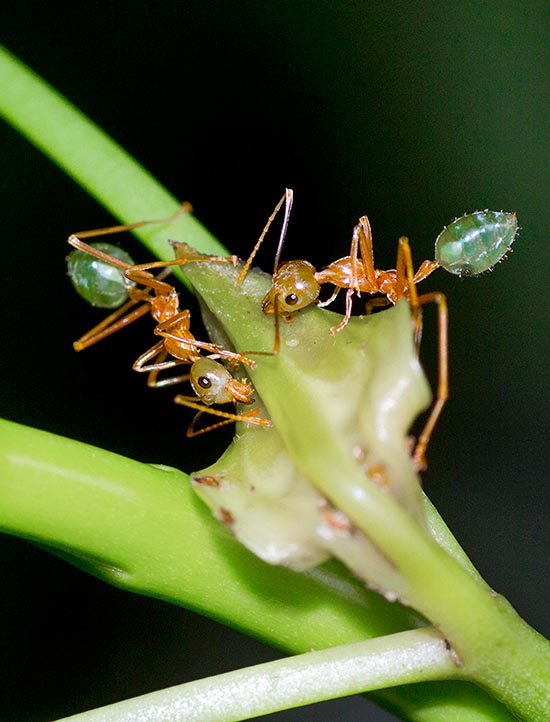
Weaver ants (Oecophylla smaragdina) have very vast diffusion. They are present in southern India and in South East Asia, up to New Guinea and northern Australia © Giorgio Venturini
The Weaver ant (Oecophylla smaragdina Fabricius, 1775) is a hymenopteran belonging to the family of the Formicidae.
To the same genus belongs only another species, Oecophylla longinoda (Latreille, 1802) present in sub-Saharan Africa. We have knowledge of several fossile species having lived in Europe between the Eocene and Oligocene.
The name of the genus Oecophylla comes from the Greek “oikos” (οἶκος), = house and “phyllon” (φύλλον) = leaf, hence “that lives in the leaves”, the species smaragdina comes from the Latin “smaragdus”, in its turn from the Greek “smaragdos” (σμάραγδος) = emerald, due to the characteristic green colour.
Zoogeography
The weaver ant is present in southern India, in South East Asia, up to New Guinea and northern Australia.
Some subspecies are recognized. Here is their localization:
Oecophylla smaragdina var. fuscoides Karavaiev, 1933 – Indonesia (Java). Indomalaya.
Oecophylla smaragdina var. gracilior Forel, 1911 – Indonesia (Java).
Oecophylla smaragdina var. gracillima Emery, 1893 – Indonesia (Batjan I). Australasia.
Oecophylla smaragdina var. selebensis Emery, 1893 – Indonesia (Sulawesi). Indomalaya.
Oecophylla smaragdina var. subnitida Emery, 1892 – New Guinea. Australasia.
Ecology-Habitat
The habitat is essentially that of the trees of the tropical forests, but in the tropical ambients the nests may be found also on roofs of dwellings and on electrical or telegraph poles. The feeding is based on small invertebrates the workers do hunt actively, on the honeydew produced by insects, such as aphids and soft scales (Homoptera), these ants breed and “milk” and also from nectar and vegetal secretions.
Morpho-Physiology
The workers of Oecophylla smaragdina belong to two classes in terms of size, a bigger one, of 8-10 mm and one smaller, of about one half. In an adult colony do not exist individuals of intermediate size. The queen, the biggest, reaches the 20-25 mm, is winged but loses the wings after the mating. The males, smaller, are winged.
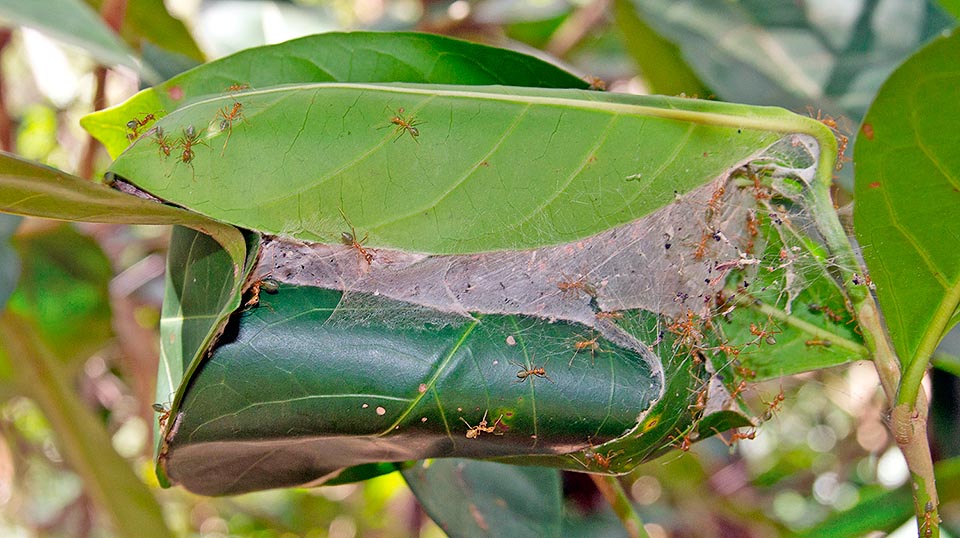
They live on the tropical forests trees in nests of leaves, pasted with the silk produced by the larvae, connected each other in huge colonies. In Asia these are usually monogenic, having only one queen. In Australia are on the contrary present polygynous and at times polyndrous colonies, that is coming from more males. In the case of polygynous colonies the queens live in the same nest, but in different compartments. The queens, winged only for mating and founding new colonies, reach the 20-25 mm © Giorgio Venturini
The colour is variable, from brown-reddish to yellow, with head and gaster (abdomen) often green, especially in the Australian specimens.The head is big, wider on the back than in front, with rounded sides, very convex above. Well developped mandibles, triangular, with straight lateral margins, curved apical tooth and numerous short denticles. Long antennae, formed by 12 segments, with the terminal two club-saped and very long first funicular segment. Very short palps, the maxillar ones with 5 segments, the labial with four segments. The eyes are big, more than in most other ants and ocelli are absent. Long and narrow thorax. Long and slender petiole, almost cylindrical. Short gaster, approximately elliptic, with pointe extremity. Typical feature is the capacity of the gaster of reflecting on the mesosoma.
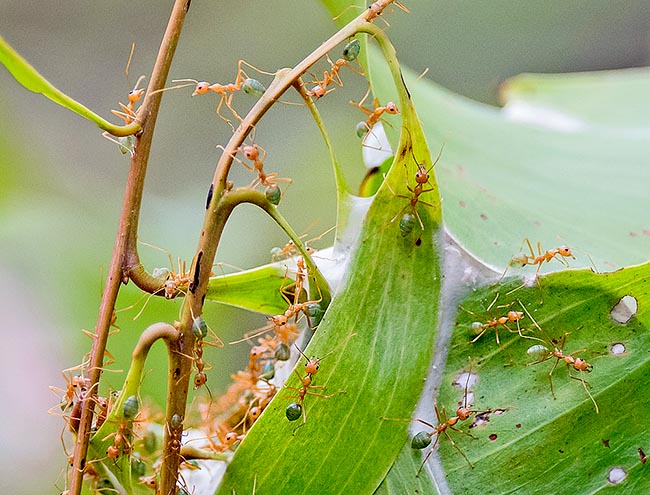
As the number of individuals increases more nests are built, even half a metre wide, usually located on more adjacent trees, connected by branches or climbers. The territory of a colony may be even of 1000 m2 © Gianfranco Colombo
Ethology-Reproductive Biology
Oecophylla smaragdina is well known due to the complex cooperative behaviour used during the construction of the nests. The first description of this interesting phenomenon is probably due to the English naturalist Joseph Banks, who took part to the expedition of Capt. Cook of 1768-1771.
The colonies of the weaver ant, that can count even half a million of workers, are distributed in a huge number of nests and, mainly in Asia, are usually monogynyous, which means that they have only one queen.
Conversely, in Australia are common the polygynous colonies and at times also polyandrous, that is coming from more males. In the case of polygynous colonies the queens live in the same nest, but in different compartments.
The queen, winged, flies searching a male and then mates, flying or on a plant or even of the ground with one or more males. After mating it goes looking for a suitable place for creating the new colony, loses the wings and begins to lay the first group of eggs on a leaf and then feeds the larvae till when they develop in workers.
The pupae appear usually after 17 days, even if these times may vary depending on the temperature, and after 28 days emerge the first workers. These ones are of intermediate size in respect to the two dimensional castes, major and minor, typical of a mature colony, and start the construction of the nests.
When the colony will be finally formed the queen continues to lay, the eggs and the youngest larvae remain in the same nest of the queen, whilst the bigger larvae are carried by the workers into the various nests.
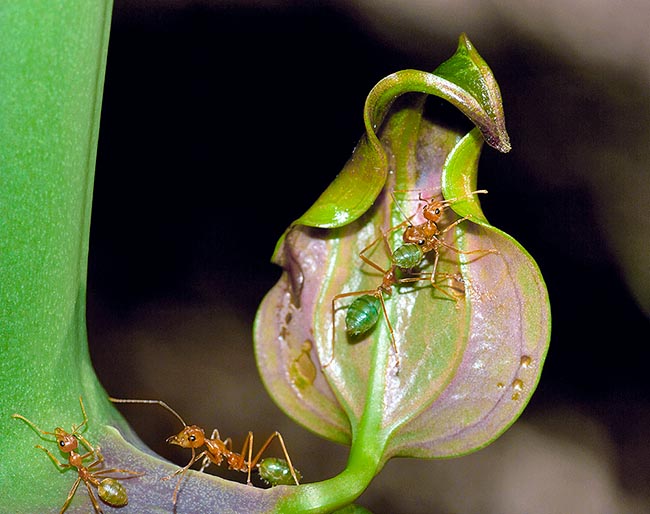
In the adult colonies are two types of woerkers: one bigger, of 8-10 mm and a smaller, of about the half. The feeding of the Oecophylla smaragdina is of small invertebrates, sent off by the workers, the honeydew made by insects, like aphids and coccids often grown in the nest for milking, but also of the nectar of the flowers without ignoring the vegetal secretions. The workers ot the weaver ants have a really incredible strength and adhesion capacity, as can sustain and carry a weight 100 times bigger than that of their body © Giorgio Venturini
From the fecundated eggs come to life the workers and the queen, diploid, whilst from the non fecundated may come the males, haploid, but usually these eggs are used as food for the larvae. At times the workers can produce sterile eggs, also used as food. Only when the colony is mature it will produce other queens and males for future colonies.
The mechanisms that determine the birth of a queen or of a worker in particular for this species have not been deeply studied, but on the base of what is known for similar species, it seems that ambiental and nutritional factors have their own part. A more abundant alimentation, rich of honeydew of aphids and of nectar favours the birth of a queen.
Also the dimensions of the egg seem to be important and an essential rôle is done by the pheromones produced by the queen, that inhibit the birth of new reproducers.
The duration of a colony is estimated to be of about eight years, before that new males and new queens are produced. If the queen dies some workers activate the ovaries becoming fertile and produce new males, even if this reactivation may take long as the corpse of the queen goes on in releasing pheromones that inhibit the activation of the ovaries of the workers. These carry on the essential duties for the survival of the colony, as caring and breeding the larvae, supplying food, building and maintaining the nests and defending, exchanging chemical and tactile signals to coordinate the work.
The salient feature of the colonies stands in the great nests done with shriveled leaves and “sewn” with the silk produced by the larvae, well visible on the trees of the forests hosting this ant. As the numbers of individuals increases, are built more and more nests, placed usually on several adjacent trees or, better, connected by branches or climbers. The size of every nest are quite variable and some reach the height of almost half a metre.
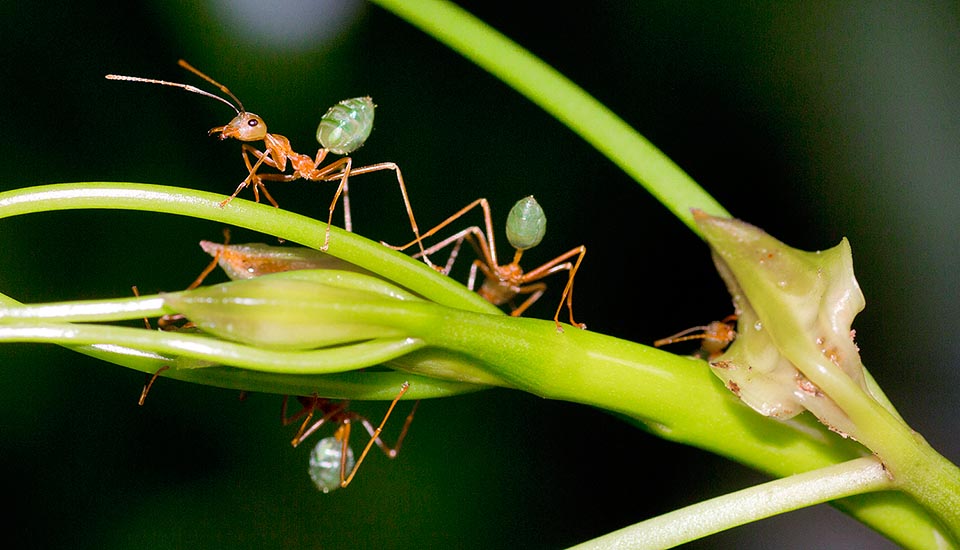
The definition and control of the territory of the Oecophylla smaragdina are based on a complex repertoire of chemical signals. The patrolling of such a vast surface is facilitated by the subdivision of the colony in many nests, each one controlling a specific zone, entrusted mainly to old workers lodged in special nests stations at the boundaries of the territory. A mechanism of enemy identification, probably of chamical nature, triggers the attack against the invader © Giorgio Venturini
We have seen that two castes of workers do exist, major and minor, with different functions: the big ones build the nests, find the food and defend the colony, whilst the small ones, that usually keep inside the nests, care and protect the larvae and get the honeydew of the insects they breed for such purpose. As defence from the intruders, the weaver ants, having no sting, recur to their strong jaws whose bites are associated with splashes of formic acid. The effects may aver very painful also for the man.
Oecophylla smaragdina is an arboreal ant who for the construction of the nests utilizse a complex technique. In fact, the workers, in numerous groups, grab with the jaws the margins of the leaves and crumple them. In order to approach distant foliar margins, they merge to form long chains, where every ant grasps with the mandibles the petiole of the preceding one, facilitated in this by the high mobility of its companion’s gaster. The edges of the crumpled leaves are then stuck using the silky secretion of the larvae: some workers, holding between the mandibles the larvae, make they slide along the margin of the leaves.
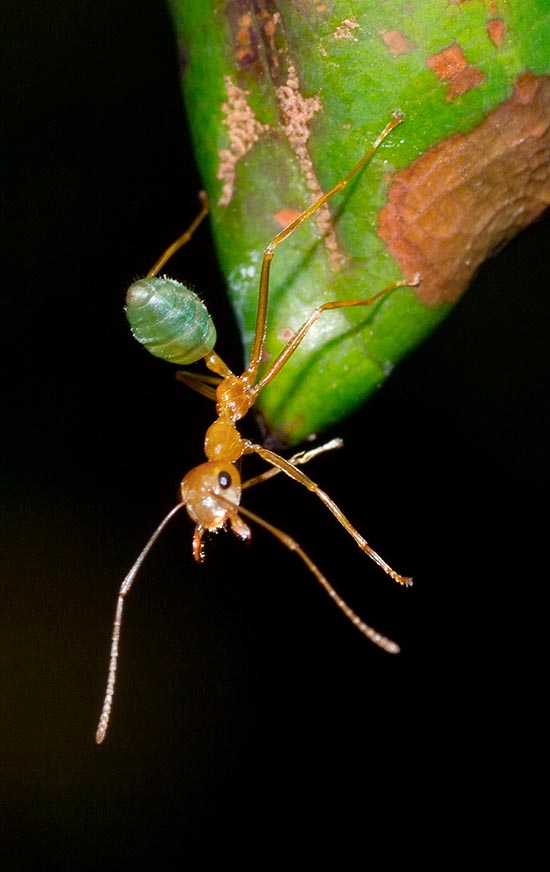
For defending against the intruders, having no sting, weaver ants use their strong jaws whose bites, very painful also for man, are associated to sprays of formic acid. Conversely, their green abdomen is edible: a quite pleasant taste reminding a sugary lemonade. These insects are locally also a source of proteins, sugars, vitamins C, E, B1, PP, mineral salts and antiinflammatories © Giorgio Venturini
Workers and larvae together work as a sort of mobile sewing machine. The adults do not produce such secretion.
This behaviour, that originates the common name of weaver ant, must lead to consider Oecophylla smaragdina as one of the few non primates animals able to utilize a tool.
The workes have extraordinary strength and adhesion capacity: they can support a weight equal to 100 times that of their weight. The adherence to smooth surfaces is probably helped by the presence of a thin veil of a liquid secreted by their legs.
The definition and the control of the territory are based on a complicated repertoire of chemical signals. The territory of a colony occupies an area that may be ampler than 1000 sq.m and that occupies even more than 20 trees. The patrolling of such a vast surface is facilitated by the subdivision of the colony in many nests, each one controlling a specific zone and is entrusted mainly to old workers lodged in special station nests placed at the boundaries of the territory. A mechanism of identification of the enemy, probably of chemical nature, triggers the attack against the invader.
Given the complexity of these colonies diffused on many nests it is not surprising that the weaver ant hosts a variety of guests, as diners, symbionts or parasites.
Among the parasites we remind the salticidae spider Cosmophasis bitaeniata that can enter the nests protected by chemical signals that imitate those produced by the ants and then predates the larvae. In spite of the chemical protection, the spider is not completely safe from the attacks of the bigger ants, that, of course, tries to avoid.
An interesting case of mimicry is that if the small Asian salticidae spider Myrmarachne plataleoides that takes advantage from its remarkable morphological resemblance with the weaver ant to live close to the nests of this one and consequently being protected against other predators that are very careful not to approach, seen the aggressiveness of the ants.
In South-East Asia Oecophylla smaragdina holds a symbiotic relationship with Anthene emolus, an obliged mimicking lycaenid butterfly. The females of the butterfly lay the eggs near the nests of Oecophylla smaragdina and the larvae are adopted by the ants who carry them into the nest, where they will feed of the leaves. If necessary, the caterpillar emits pheromones that attract the workers who will take care of its needs. The larvae, that cannot survive outside the nests, where are continuously cared by the ants, secrete nourishing liquids very much appreciated by the ants. The substances produced by the butterfly’s larvae represent an important energic input for the ants.
The pupae, though not producing attractive liquids, are not however attacked by the ants, whilst after the hatching the adults are not protected from the attacks and must immediately get away from the nests in order not to be killed. Eight species of lycaenid butterflies in Australia are known to hold the same relationship with the weaver ant.

Typical of Oecophylla smaragdina is the capacity to unite, to form long and solid chains, seizing with the mandible the petiole of the preceding companion © Giorgio Venturini
Utilizations by humans
The weaver ants, eggs, or larvae or adults, stand among the most appreciated insects as food, for the man as well as for the domestic animals, for their pleasant taste and for their healing properties. Oecophylla smaragdina is rich of proteins, sugars, vitamina C, E, B1, PP, mineral salts and anti-inflammatories. In some countries such as Thailand, they are sold at high prices and their trade contributes in a major way to the economy of some regions. In Indonesia is diffused the use of the larvae that are commercialized as food for birds or as bait for fishing, whilst in India, China and Australia the local populations use it widely as food or in the traditional medicine.
The Aborigenals of Australia use it for sweetening the water, they squeeze its abdomen in the mouth as food and use it as medicament against respiratory diseases. The taste of the squeezed abdomen (for author’s personal experience) is very pleasant and reminds a sugary lemonade, with the formic acid responsible of the sour taste, whilst the sweet taste is probably due to the honeydew or to the product of the caterpillars of the symbiont butterflies assumed with the alimentation.
The Australian Aboriginals boil the nests and then drink the filtered liquid, or do inhale the steam during the boiling (who has invented the aerosols for bronchitis?). They also use to rub the ants on the skin, as revulsive. The women in labour rub the nests on their breasts in way that the ants bite them and the inflammation thus caused facilitates the production of milk.
In Kerala (India), tribal groups use the crushed ants for getting a “spicy sauce” due to presence of formic acid. They also get an oil extracting by heat the minced ants, utilized for the arthritides and the inflammations. The secretion of the abdominal glands has antibacterial and antifungal action.
The weaver ants, besides being hunters and greedy of the honeydew of other insects, are also attracted by the nectar or by other sugary substances secreted by plants. This means that the involved plants, by attracting the aggressive and ravenous ants, get from them a protection against insects or other animals eating leaves. The man has exploited since the old times this characteristic and in fact the weaver ants represent probably the oldest documented case of utilization of an insect for the biological struggle against the parasites of the cultivations. Already around the a.D. 300 the Chinese countrymen in fact spread the colonies of Oecophylla smaragdina in the citrus cultivations to fight the parasites and the nests of the ants were traded for this purpose. For encouraging the ants to colonize all the trees, they used to place bamboo sticks between a tree and another as connecting “bridges”.
Presently, in some countries they are resuming this practice as alternative to the use of chemical insecticides to fight also parasites of the mango and of other plants, for instance in the struggle against the stink-bug Cyclopelta siccifolia which infests Pongamia pinnata, an Asian tree of commercial interest due to its medicinal properties.
Other interestin rôle of the Oecophylla smaragdina is that of acting as pollinator, an important fact in some Australian regions where other pollinators are missing for plants of high agricultural interest such as mangoes and tangerines.
The colonies of the weaver ant, besides having a positive action for the plants hosting them, fighting the parasites, can also have a negative effect, turning away animals useful for the pollination of the flowers and the dispersion of the seeds, as well as protecting dangerous animals such as the scale insects and aphids that the ants breed for getting the honeydew.

So doing, the workers can unite, pulling synchronizeed, distant foliar margins and then paste them using the silky secretion of the larvae they slide , holding them with the jaws, as if they were tubes of glue. Perhaps the only insect that, like some primates, has learnt to use a tool. This ant serves now also for the biological struggle and the silk of the larvae is studied as interesting biomaterial for the adhesion of human cells in cultivation, talking of tissues transplants © Giorgio Venturini
Like the silk produced by the spiders and the silkworms, also that of the larvae of Oecophylla smaragdina has aroused the interest of the scholars as potential biomaterial in particular as matrix for the adhesion of human cells in cultivation for tissues transplants.
Synonyms
Formica virescens (Fabricius); Formica viridis (Kirby); Camponotus smaragdinus (Fabricius); Echophylla virescens (Fabricius); Formica smaragdina (Fabricius); Formica macra (Guérin-Méneville); Formica zonata (Guérin-Méneville);
Lasius virescens (Fabricius); Oecophylla macra (Guérin-Méneville); Oecophylla virescens (Fabricius); Oecophylla viridis (Kirby).
